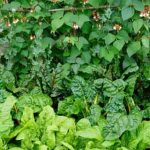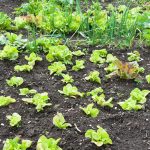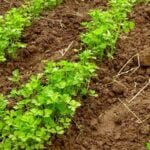The Timber Press Guide to Vegetable Gardening in the Midwest is an invaluable resource for gardeners in this region. With its comprehensive information and practical tips, this guide serves as a go-to manual for anyone looking to cultivate a successful vegetable garden in the heartland of America.
Gardening in the Midwest comes with its own unique set of challenges, including unpredictable weather patterns, diverse soil conditions, and specific pests and diseases. This is why having a gardening guide specifically tailored to the region is vital. The Timber Press Guide provides targeted advice and suggestions that take into account the distinct characteristics of Midwestern gardening, helping both novice and experienced gardeners navigate the intricacies of growing vegetables successfully.
In The Timber Press Guide to Vegetable Gardening in the Midwest, readers will find a wealth of information tailored to their specific needs. From plant recommendations based on regional climate conditions and optimal planting schedules to strategies for dealing with pests and diseases organically, this book covers all aspects of vegetable gardening. Whether you have limited space or abundant land, this guide offers solutions for maximizing yield throughout the growing season.
With The Timber Press Guide to Vegetable Gardening in the Midwest as your companion, you can approach your vegetable garden with confidence, knowing that you have expert knowledge at your fingertips. So get ready to dig in, plant your seeds, and reap the rewards of a bountiful harvest with this indispensable resource by your side.
Importance of regional gardening guides
One of the most significant challenges faced by gardeners is adapting their techniques to suit the unique climate, soil conditions, and challenges of their region. This is especially true for Midwest gardeners who confront a variety of specific factors that can greatly impact the success of their vegetable gardens. That is why having a gardening guide specifically tailored to the Midwest, such as The Timber Press Guide to Vegetable Gardening in the Midwest, is of utmost importance.
The Midwest region experiences a range of climate conditions from hot summers to cold winters, making it essential for gardeners to understand how these factors affect their vegetable gardens. By providing detailed information about the climate in the area and its impact on gardening, this regional guide becomes an invaluable resource. The book covers various USDA hardiness zones present in the Midwest and offers cultivated plant varieties that are known to succeed in these conditions.
Moreover, soil plays a crucial role in determining the health and productivity of plants. The soil conditions differ across regions and can greatly influence growing success. The Timber Press Guide to Vegetable Gardening in the Midwest recognizes this and includes specific recommendations for soil preparation techniques that are geared towards enhancing plant growth in this particular region. It provides guidance on conducting soil tests and amending the soil with organic matter or fertilizers as needed.
Overall, having a gardening guide specifically designed for the Midwest is highly advantageous for vegetable gardeners in this region. It addresses the unique challenges posed by its climate, soil conditions, and other factors that may hinder successful gardening endeavors. By utilizing such a resource like The Timber Press Guide to Vegetable Gardening in the Midwest, gardeners can gain valuable insights and knowledge to help them achieve thriving vegetable gardens despite upholding obstacles they might face.
Overview of the book
The Timber Press Guide to Vegetable Gardening in the Midwest is a valuable resource for any gardener in the region. This comprehensive book provides a wealth of information specifically tailored to the unique climate, soil conditions, and challenges faced by gardeners in the Midwest. Whether you are a beginner or an experienced gardener, this book offers a wide range of tips and strategies to help you successfully grow vegetables in your backyard.
One of the main features of this book is its extensive plant recommendations. It provides detailed information on various vegetable varieties that are well-suited for the Midwest climate. Whether you are looking to grow tomatoes, peppers, cucumbers, or leafy greens, you will find helpful suggestions and guidance on which varieties to choose for optimal yields. Additionally, it includes planting schedules that outline the best times to sow seeds or transplant seedlings based on your location within the Midwest.
Another valuable aspect of The Timber Press Guide to Vegetable Gardening in the Midwest is its focus on pest control strategies. The book offers organic methods for managing common pests and diseases that can affect vegetable gardens in this region. It emphasizes environmentally friendly practices to ensure healthy crop growth while minimizing harm to beneficial insects and pollinators. By following these recommended strategies, gardeners can maintain a balanced ecosystem within their gardens and achieve successful harvests.
Overall, The Timber Press Guide to Vegetable Gardening in the Midwest is an essential companion for Midwest gardeners seeking expert advice and guidance. With its detailed plant recommendations, planting schedules, and pest control strategies, this book equips readers with all the tools they need to cultivate thriving vegetable gardens throughout the year.
Whether you are just starting out as a gardener or have been growing vegetables for years, this book will serve as a valuable resource that will enhance your knowledge and yield from your garden.
Understanding the Midwest climate
The Midwest region of the United States encompasses a wide range of climate conditions that can significantly impact vegetable gardening. From hot summers to cold winters, gardeners in the Midwest face unique challenges when it comes to growing vegetables. Understanding the climate is crucial for successful gardening, as it determines what plants will thrive and when to plant them.
One key factor to consider is the USDA hardiness zones present in the Midwest. These zones are a helpful tool for determining which plants are most likely to survive in a particular region. The Timber Press Guide to Vegetable Gardening in the Midwest provides valuable information on each zone’s characteristics, allowing gardeners to choose appropriate varieties accordingly.
In adapting gardening techniques to the Midwest climate, timing is essential. The book provides planting schedules tailored specifically to this region, taking into account factors such as frost dates and temperature fluctuations. By following these schedules, gardeners can maximize their chances of success by planting at optimal times.
Additionally, understanding soil conditions is vital for thriving vegetable gardens in the Midwest. The region’s diverse soils require specific attention, ranging from sandy soils that drain quickly to heavy clay soils that retain moisture. The Timber Press Guide offers useful advice on soil testing methods and recommendations for amending soil based on its composition.
To adapt to varying climates within the region, gardeners should also consider using season extenders such as cold frames, hoop houses, and row covers. These structures can help protect plants from frost and provide a few extra weeks of growing time in both spring and fall. The book shares tips and techniques for utilizing these tools effectively.
Gardening successfully in the Midwest requires an understanding of its diverse climate conditions and adapting techniques accordingly. The Timber Press Guide serves as a comprehensive resource that helps gardeners navigate these challenges with confidence. By providing information about USDA hardiness zones, planting schedules, soil preparation techniques, and season extenders, this book equips Midwest gardeners with the knowledge they need to grow a bountiful vegetable garden throughout the year.
Soil preparation techniques
Soil preparation is a critical step for successful vegetable gardening in the Midwest. The unique climate and soil conditions in this region require special attention to ensure optimal plant growth and yield. In this section, we will discuss the importance of soil preparation techniques, recommended soil testing methods, and how to amend the soil for optimal results.
Understanding the Soil
Before diving into soil preparation techniques, it’s crucial to understand the characteristics of your soil. The Midwest is known for its diverse range of soil types, including clay, loam, and sandy soils. Each type has different drainage capabilities and nutrient-holding capacity. By understanding your soil type, you can make informed decisions about how to amend it effectively.
Soil Testing Methods
Conducting a soil test is essential to determine the pH levels and nutrient deficiencies or imbalances in your garden soil. There are various ways to test your soil, such as using DIY kits or sending samples to a reputable lab for analysis. The Timber Press Guide to Vegetable Gardening in the Midwest recommends conducting a comprehensive lab analysis for an accurate assessment of your soil’s composition.
Amending the Soil
Once you have identified any deficiencies or imbalances in your soil through testing, it’s time to amend it accordingly. The book provides valuable guidance on choosing the right amendments based on your specific needs. Common amendments include compost, aged manure, limestone (to adjust pH levels), and organic matter like peat moss or coconut coir. Understanding proper ratios and application methods is crucial for achieving optimal plant growth.
By following these soil preparation techniques outlined in The Timber Press Guide to Vegetable Gardening in the Midwest, gardeners can create a fertile foundation that promotes healthy plant growth and maximizes their vegetable yield. Remember that tending to your garden’s soil is an ongoing process, as regular maintenance through top-dressing with compost and organic matter is vital for long-term soil health. With a well-prepared soil, Midwest gardeners can enjoy bountiful harvests year after year.
Recommended vegetable varieties for the Midwest
When it comes to vegetable gardening in the Midwest, choosing the right varieties of vegetables is crucial for success. The Timber Press Guide to Vegetable Gardening in the Midwest provides a comprehensive list of recommended vegetable varieties that are well-suited to thrive in this specific climate. Understanding their characteristics, optimal planting times, and tips for maximizing yield can help gardeners make informed decisions and achieve fruitful harvests.
One of the key considerations when selecting vegetable varieties for the Midwest is their tolerance to fluctuations in temperature and weather conditions. Certain varieties are better suited to withstand the region’s cold winters and hot summers. For cool-season crops like lettuce, spinach, and radishes, varieties such as ‘Grand Rapids’ lettuce, ‘Bloomsdale’ spinach, and ‘Cherry Belle’ radishes thrive well during spring and fall. These varieties have been selected for their ability to tolerate mild frosts and produce quality yields.
For warm-season crops like tomatoes, peppers, and cucumbers, it is important to select varieties that have good heat tolerance and resistance to common pests present in the region. ‘Celebrity’ tomatoes, ‘California Wonder’ peppers, and ‘Marketmore 76’ cucumbers are highly recommended options that perform well in the Midwest. These varieties have proven track records for producing abundant yields even in challenging weather conditions.
Optimal planting times also play a vital role in successful vegetable gardening. The book provides specific recommendations on when to sow seeds or transplant seedlings for each vegetable variety mentioned. These timing guidelines take into account both average frost dates and historical climate data specific to different areas within the Midwest region.
In addition to timing considerations, there are various tips provided in The Timber Press Guide to Vegetable Gardening in the Midwest that can help maximize yield potential. From proper spacing between plants to ensuring adequate watering and nutrient management practices, these recommendations aim at equipping gardeners with practical know-how to achieve the best results.
| Vegetable | Variety | Characteristics | Optimal Planting Times |
|---|---|---|---|
| Lettuce | Grand Rapids | Tolerant to mild frosts, crisp texture, and sweet flavor. | Spring and Fall |
| Tomatoes | Celebrity | Disease-resistant, large fruits with excellent flavor. | After last frost date in spring |
By considering these recommended vegetable varieties and their specific characteristics, optimal planting times, and tips for maximizing yield, gardeners in the Midwest can confidently select the right vegetables for their gardens and enjoy a productive harvest. The Timber Press Guide to Vegetable Gardening in the Midwest serves as an invaluable resource in making informed gardening decisions.
Pest and disease management
Pest and disease management is a crucial aspect of successful vegetable gardening in the Midwest. The unique climate and environmental conditions in this region can make certain pests and diseases more prevalent, requiring gardeners to be informed and proactive in their approach to keeping their plants healthy. In The Timber Press Guide to Vegetable Gardening in the Midwest, gardeners will find a wealth of information and practical advice on how to effectively manage common pests and diseases organically.
Identifying common pests
One of the first steps in effective pest management is being able to identify common pests that plague vegetable gardens in the Midwest. The Timber Press guide provides detailed information on various insects, such as aphids, cabbage worms, cucumber beetles, and tomato hornworms. By learning about their appearance, life cycle, and feeding habits, gardeners can take appropriate action before infestations become severe.
Strategies for organic pest control
The Timber Press guide emphasizes organic methods for pest control that are safe for both the environment and the gardener’s health. These strategies involve promoting biodiversity by attracting beneficial insects that prey on harmful pests. For example, planting flowers like marigolds, zinnias, and lavender can attract pollinators and predatory insects such as ladybugs and lacewings.
Additionally, physical barriers like row covers or netting can be used to protect susceptible plants from insect damage. Companion planting techniques are also discussed, which involve growing certain plants together that have natural repellent effects on pests or mask the scents of vulnerable plants.
Disease prevention and management
The Timber Press guide offers comprehensive information on common plant diseases found in the Midwest region. It highlights preventive measures such as crop rotation, proper sanitation practices (like cleaning tools), and careful selection of disease-resistant varieties. The use of biological control agents like beneficial fungi is also discussed as an effective means of managing plant diseases without resorting to chemical treatments.
Gardeners are encouraged to regularly monitor their plants for signs of disease, such as wilting, discoloration, or growth abnormalities. Early detection can help prevent the spread of diseases and allow for prompt action, such as pruning infected plant parts or applying organic fungicides.
By following the strategies and organic pest control methods recommended in The Timber Press Guide to Vegetable Gardening in the Midwest, gardeners can effectively manage pests and diseases while promoting a healthy and thriving vegetable garden.
Seasonal gardening calendar
The Timber Press Guide to Vegetable Gardening in the Midwest provides a valuable resource for gardeners in the region by offering a comprehensive, month-by-month gardening calendar tailored specifically to the unique climate and conditions of the Midwest. This section of the book serves as a guide for gardeners, outlining key tasks and planting schedules for each month to help them stay on track throughout the year.
In January, gardeners in the Midwest should focus on planning and preparation. It is a good time to order seeds and create a planting schedule for the upcoming growing season. Indoor seed starting can also begin for long-season crops such as tomatoes and peppers. Additionally, this is an ideal time to evaluate tools and equipment, ensuring they are clean and in good working condition.
As February rolls around, it’s time to start more seeds indoors. Cool season vegetables like lettuce, spinach, and broccoli can be started inside during this month. Gardeners should also keep an eye on weather forecasts for any potential early thawing or warm spells that may allow for outdoor work. Mulching existing plants in the garden can help protect them from extreme temperature fluctuations.
March marks the beginning of spring and signals that it is time to start preparing soil beds. Gardeners can remove winter coverings from gardens, test soil pH levels, and add organic matter or compost if necessary. It’s also an excellent time to sow peas directly into prepared beds. Indoors, continue starting seeds for warm-season crops like cucumbers, melons, and squash.
April is a busy month in terms of planting vegetables outdoors. As temperatures continue to rise, hardy cool season crops such as radishes, carrots, beets, and lettuce can be sown directly into freshly prepared beds. Transplanting seedlings of cool-season crops started indoors earlier should also begin now. Tending to weed control becomes crucial at this stage to prevent competition with young plants.
By providing specific tasks and planting schedules for each month, The Timber Press Guide to Vegetable Gardening in the Midwest ensures that gardeners have a clear and organized plan. This allows them to stay on track and maximize their yields throughout the year, ultimately leading to a successful vegetable garden in the challenging Midwest climate.
Tips for extending the growing season
Extending the growing season is a valuable technique for Midwest gardeners who want to enjoy fresh vegetables for a longer period. By utilizing various techniques such as cold frames, hoop houses, and row covers, gardeners can protect their plants from frost and extend their harvest well into the fall.
Cold frames are essentially mini greenhouses that trap heat and protect plants from harsh winter conditions. These structures are typically made of a transparent material such as glass or plastic and are placed over beds or individual crops. Cold frames utilize solar energy to create a microclimate that is warmer than the surrounding environment, allowing plants to thrive even during colder months.
Hoop houses, also known as polytunnels or high tunnels, are another effective method for extending the growing season in the Midwest. These structures consist of curved metal or PVC pipes covered with greenhouse-grade plastic. Hoop houses create a protective shield around plants, trapping warm air inside and shielding them from frost. They can accommodate larger crops and provide ample space for gardeners to tend to their plants throughout the season.
Row covers are lightweight fabrics that can be easily draped over vegetable beds or individual rows. These covers help retain heat during chilly nights, protect plants from pests, and provide shade during hot summer days. Row covers also allow sunlight, water, and air to reach the plants while creating a barrier against adverse weather conditions.
| Technique | Description | Benefits |
|---|---|---|
| Cold Frames | Mini greenhouses that trap heat | – Protect plants from frost
|
| Hoop Houses (Polytunnels) | Curved structures covered with greenhouse-grade plastic | – Shield plants from frost and harsh weather
|
| Row Covers | Lightweight fabrics draped over beds or rows | – Retain heat and protect against pests
|
These techniques for extending the growing season offer Midwest gardeners the opportunity to enjoy fresh vegetables for a longer period. By implementing these practices and following the recommendations in The Timber Press Guide to Vegetable Gardening in the Midwest, gardeners can maximize their harvests and savor homegrown produce well beyond the typical growing season.
Conclusion
In conclusion, The Timber Press Guide to Vegetable Gardening in the Midwest is an invaluable resource for gardeners in this region. By providing tailored information on climate, soil conditions, and challenges specific to the Midwest, this book equips gardeners with the knowledge they need for successful vegetable gardening.
With its comprehensive coverage of plant recommendations, planting schedules, pest control strategies, and more, this guide offers a wealth of information to enhance vegetable gardening knowledge and yield. Whether you are a beginner or an experienced gardener, this book provides valuable insights and practical tips to help you navigate the unique conditions of the Midwest.
To further enhance your vegetable gardening journey, I encourage you to explore The Timber Press Guide to Vegetable Gardening in the Midwest in detail. Take advantage of its month-by-month gardening calendar, which outlines key tasks and planting schedules specific to our region. Consider trying out recommended varieties that thrive in the Midwest climate and make use of organic pest control methods suggested by experts.
Remember that gardening is a continuous learning process, and this comprehensive resource can be your trusted companion throughout your journey. So dive into The Timber Press Guide to Vegetable Gardening in the Midwest and let it empower you with knowledge and inspiration as you create a thriving vegetable garden in our beautiful region.
Frequently Asked Questions
What is the best layout for a vegetable garden?
The best layout for a vegetable garden ultimately depends on various factors such as the available space, sunlight exposure, soil quality, and personal preference. However, there are a few general principles to consider. Firstly, it is crucial to ensure that the garden receives sufficient sunlight throughout the day, so placing taller plants on the northern side or avoiding shading by nearby trees or structures is essential.
Secondly, arranging plants in rows or raised beds makes it easier to access and maintain the garden while providing adequate spacing for healthy growth. Additionally, considering companion planting can help maximize space utilization and deter pests naturally. Lastly, incorporating paths between rows or beds not only aids in maintenance but also prevents soil compaction and facilitates efficient watering.
What are the 3 most popular vegetables grown in the home garden in the USA?
The three most popular vegetables commonly grown in home gardens across the USA are tomatoes (Solanum lycopersicum), peppers (Capsicum annuum), and cucumbers (Cucumis sativus). Tomatoes hold enormous popularity due to their versatility in various culinary dishes and home preserving methods like canning or salsa making.
Peppers come in different varieties with different levels of heat (from mild bell peppers to hotter chili peppers) and are suitable for adding flavor and color to various meals. Cucumbers are highly favored for their crisp texture and refreshing taste, often enjoyed fresh in salads or pickled.
How do you grow vegetables on a steep slope?
Growing vegetables on a steep slope presents its own set of challenges but can be accomplished with some careful planning and adjustments. Firstly, terracing the slope helps create level planting areas that prevent soil erosion while allowing water retention. Building retaining walls or using sturdy raised beds can achieve terracing effects effectively. Secondly, ensuring proper water drainage is crucial on slopes as excessive water runoff could lead to erosion or suffocate plant roots.
Installing drip irrigation systems or digging channels can redirect excess water away from the plants while watering them sufficiently. Thirdly, amending the soil with organic matter helps improve its fertility and drainage capabilities, which is even more crucial on slopes where the soil might be prone to erosion. Additionally, planting grass or ground cover plants between beds can help stabilize the soil further and prevent erosion.

If you’re looking to get into vegetable gardening, or are just looking for some tips on how to make your current garden better, then you’ve come to the right place! My name is Ethel and I have been gardening for years. In this blog, I’m going to share with you some of my best tips on how to create a successful vegetable garden.





